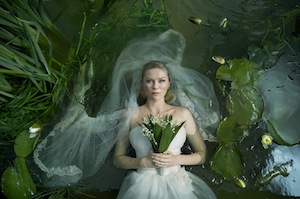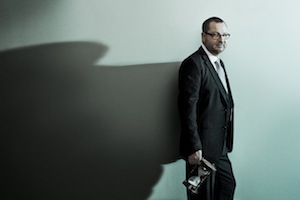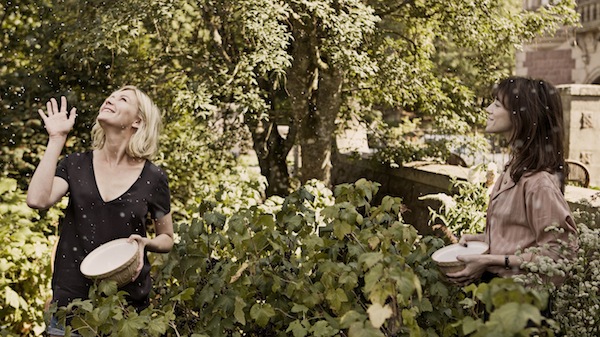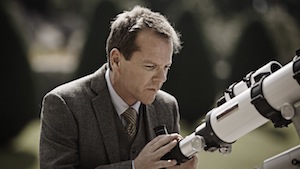WHEN WORLD'S COLLIDE; LARS TRIER'S MELANCHOLIA
 Sunday, November 20, 2011 at 08:25PM
Sunday, November 20, 2011 at 08:25PM By Marcus Liberski
I’m a great fan of Lars von Trier’s work. As a Dane, I grew up with his films and media appearances. He is one of the most innovative and groundbreaking directors alive and capable of masterpieces, as he has proven.
The financing for Trier’s films comes from institutional investors across Europe. Contrary to the U.S. system, the European states heavily support the film industry, giving money the filmmakers have no obligation to return and so they never worry about box office numbers.
State financing requires extensive applications. It takes weeks and months to create and compile the necessary material. In the Danish film industry, the myth goes that Trier marks his application with a couple of crosses and his signature and always gets what he asks for. That’s a good indication of Trier’s special status within the Danish and European film industry.
Trier co-created the seminal film company Zentropa, named after the American title of Trier’s first film Europa, as counterweight to the commercially oriented Nordisk Film (Nordic Films), the oldest, still active film production company in the world. With Zentropa, Trier got the freedom he wanted, with no producer trying to control him. The company’s influence shows in the number of great films they have produced, including Thomas Vinterberg’s masterpiece Festen (The Celebration).
Zentropa also launched Pussy Power, which supposedly produced the first porn films for women. Sadly, Zentropa fell victim for the growing New Puritanism that rules the world these days. With a growing number of international co-producers, English investors forced Zentropa to cease their operations in porn. Zentropa recently merged with Nordisk Film.
Maybe these changes reduced Trier’s desire to innovate and experiment. With Melancholia Trier attempts a more commercial, audience-friendly film, although nudity, as always in his pictures, plays a pivotal role. Instead of making a controversial film, Trier, whom Helen Mirren recently described as the film industry’s version of the punk rock movement, created controversy at his press conference at this year’s Cannes Film Festival. After he announced that he understood and felt sympathy for Hitler, the Festival declared Trier persona-non-grata indefinitely – a major blow, since he has been a fixture at the festival for years. The man himself
The man himself
The first half of Melancholia centers around the main character, Justine’s (Kirsten Dunst) wedding; the second half concerns a giant planet, Melancholia, approaching Earth. We know from the opening sequence that Melancholia will destroy our planet. It’s not clear whether the guests at Justine's wedding are aware of the looming catastrophe.
Deploying tropes that appeared in Antichrist, Melancholia begins with a prologue in slow motion, accompanied by opera. This time the prologue – a long montage – aims for tone and symbolism instead of portraying a traumatic event in a poetic manner, as in Antichrist. Obviously inspired by Kubrick’s opening of Eyes Wide Shut, when Nicole Kidman takes off her underwear and sits on the toilet, Trier opens Melancholia with an extreme close-up of Dunst with greasy hair and no makeup, looking exhausted and very human – deconstructing her glamorous Hollywood image. The montage continues with symbolic images that makes no immediate sense and concludes with Earth being swallowed by Melancholia. While the prologue in Antichrist, shot at 1000 frames per second with the specialized Phantom Camera, was breathtaking and terrifying, Melancholia’s equally gorgeous opening seems flat and farfetched.
Another Trier-trademark is to divide his films into chapters. In Melancholia there are only two. They demarcate the two acts, which feature two different protagonists. Justine stars in the first and her sister Claire (Charlotte Gainsbourg), in the second. Both actors appear in each other’s chapters as supporting characters. This division provides a deeper understanding of the characters psyche and investigates their differences. Faced with the same challenges, the two sisters react in opposite ways. While Justine embraces the approaching planet and seems to find peace in its mighty, Claire feels only fear. They both react purely emotionally without any rationality – a major theme in the film as their irrationality is juxtaposed with male rationality and belief in science.
A memorable shot of the two sisters observing snow falling on a sunny summer day, perfectly captures female irrationality. The two women watch at the snow, which falls in defiance of all logic, and recognize and appreciate its beauty. In much of his prior work, Trier dealt with the theme of women’s irrationality and their surrender to the will of their emotions versus men’s rationality and belief in science.
The TV-show Riget (The Kingdom), maybe Trier’s most important work, depicts a spiritual world infiltrating the world of science at the best-equipped hospital in Northern Europe, which was built to demonstrate human control over life and death. Only an old woman believes in the spirits, but the doctors – the men of science - ridicule her. In Antichrist, Willem Dafoe believes so strongly in the effect of psychotherapy that he ignores the worrying signals of his wife’s grief. In Melancholia, Claire doubts her husband’s scientific reassurances. She instinctively worries about the approaching planet even though the scientists are certain that Melancholia won’t hit Earth. In these depictions of the differences between men and women lies the momentary greatness of Melancholia. Kiefer Sutherland appears as the uber-rational alpha-male, and where women’s embrace of the irrational seems dangerous and flawed from a rational point of view, Sutherland’s character’s blind belief in science appears even more deadly. This harkens back to Dafoe’s uncritical conviction in Antichrist.
Trier never judges his women characters as they, in a sense, portray him. Trier seems to favor female irrationality over men’s mindless belief in logic and science, which the cataclysm in Melancholia clearly illustrates. Partly because of his identification with his female character, I don’t subscribe to the choir that accuses Trier of misogyny. These accusations are a result of a misinterpretation of the director’s collective work. His attempts to understand the female psyche should be admired. Many male directors through history have failed to even make this attempt.
Trier makes melodrama, and Melancholia is no exception. The extreme family relations seem over the top even for this director. The mother hates the father, who doesn’t care. The sisters seem distant from each other, but Claire’s (Gainsbourg) husband John (Kiefer Sutherland) pays for the extravagant wedding that Justine couldn’t care less about. The characters appear somewhat constructed and caricatured. The writing leaves the actors with a difficult task and the normally magnificent Charlotte Rampling (Swimming Pool) overplays in her portrait of the disillusioned and cynical mother. Surprisingly though, considering the material but not unusual for Trier’s films, most of his cast have never been better. Kirsten Dunst deservedly won the Best Actress award at Cannes for her nuanced and realistic portrayal. Playing the chronically depressed Justine, she captures the mood swings, erratic behavior and blank stares that characterize depression. Trier said that when he lost his intended lead, Penelope Cruz (who chose Pirates of the Caribbean 4 instead), he spoke to Dunst, who confided that she used to suffer from depression. Her experiences shows in the performance.
Gainsbourg, once again, performs as if her life depends on it (Starring in Antichrist, she deservedly won Best Actress at Cannes in 2009). Her complete and utter terror as Melancholia approaches Earth seems real and quite different from the grief-stricken and deranged character she played in Antichrist.
The surprise of the film is an energetic and funny Kiefer Sutherland. In a thankless role as Claire’s wealthy, science-obsessed husband, he gives the character depth. Sutherland dismisses his rational and self-assured rejection of the possibility of a collision between the two planets with an increasing uneasiness. Although Trier wrote the script too fast (6 weeks), his direction of actors appears stronger than ever.
While the performances thrive, the camera suffers. In order to secure the best possible performances, Trier turns to flexible blocking. In Element of Crime and Europa, his camerawork resembles Kubrick’s, but without Kubrick’s gift for carefully planned frames and camera moves. Trier surrendered that kind of control to provide his actors freedom to improvise and experiment. Although his digital images suffer a rendered, computer-like depiction of color, it enables him to keep rolling, and he famously encourages his actors to try different things on each take. This technique compromises the beauty of his frames, which often look messy and unstructured. Using mostly handheld, the new collaboration with DP Manuel Alberto Claro doesn’t work as well as when Trier shoots the film himself. Trier expressed satisfaction with the collaboration after he controversially criticized DP Anthony Dod Mantle’s work on Antichrist. He felt Antichrist was too beautiful and was happier with the disorderly frames of Melancholia. I disagree. The lack of continuity and the jump cuts felt motivated and justified in Antichrist, but seem random and thoughtless in Melancholia.
As opposed to the frames progressing the narrative, the symbolic frames are exquisitely composed and stay with you long after the film ends. The shot of a horse collapsing, or Justine floating down a creek in her wedding dress, are poetic and evoked Trier’s most significant inspiration, the Russian director Andrei Tarkovski. The difference between them is that Tarkovski knew how to be subtle. Trier’s symbolism is heavy and obvious. A perfect illustration is a wide shot of Justine bathing naked and peacefully in the light of the approaching Melancholia. Justine finds peace from her depression in this giant object of doom, and metaphorically makes love to it as she lies at the side of a creek in a stunning shot, surrounded by nature, facing the oncoming planet naked. You won’t find symbolism more pronounced than that…
Trier makes Hollywood movies disguised as art films. His movies are more original, but built on the same structural rules. Melancholia is flawed, but not disappointing. At first I thought it lacked content under its appealing surface, but after thinking and writing about it, I realize that its content incites self-reflection as it entertains. Although somewhat repetitive, Trier’s two latest films show a director far from the artistic crisis that some suggest. Arriving at a new stage in his already impressive career, Trier’s directorial voice still seems strong. His capability to establish a tone amazes. The feeling of melancholia lies heavy over the entire picture in tone, music, color, pace and performance. The choice between melancholia and determinism or fatalism avoids clichés and speaks to Trier’s sense of innovation. Even though we know the end from the beginning, Trier makes sure that it’s worth the wait. And let me just finish by saying: what an end.
Marcus Liberski, a film director and cinema scholar, is pursuing his Masters Degree in Film Production at the University of Southern California.
 Dunst,
Dunst,  Lars Trier,
Lars Trier,  Melancholia,
Melancholia,  Tarkovsky,
Tarkovsky,  Zentropa
Zentropa 
